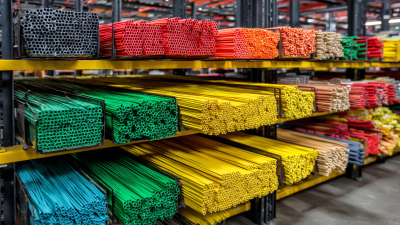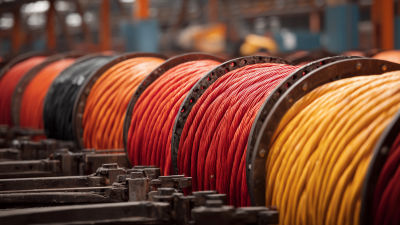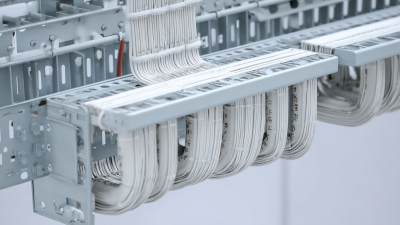Blog
Exploring Innovative Alternatives to Traditional Cable Tray Wire Systems
In recent years, the need for efficient and innovative solutions in electrical wiring management has driven the industry to explore alternatives to traditional cable tray wire systems. According to a report by MarketsandMarkets, the global cable management market is projected to reach $16.5 billion by 2026, growing at a CAGR of 12.6% during the forecast period. This growth underscores the increasing demand for effective cable management solutions that enhance safety, reduce installation time, and improve overall system performance. Traditionally, cable tray wire systems have faced criticism for their bulkiness and installation challenges. However, with advancements in technology and materials, new alternatives are emerging that promise to streamline processes and offer additional benefits, such as improved scalability and adaptability to dynamic environments. This blog will delve into the innovative alternatives available today and the numerous benefits they provide in comparison to conventional systems.

What Are Traditional Cable Tray Wire Systems and Their Limitations?
Traditional cable tray wire systems have long been a staple in electrical installations, providing a structured method for supporting and managing cables. However, as technology advances, these systems reveal several limitations, particularly in terms of flexibility, installation speed, and adaptability to modern needs. The increasing complexity of infrastructures, including demands for data transmission and integration of new technologies, highlights these shortcomings.
As the Southeast Asia and Middle East markets for copper wire and cable expand, reaching projected values of $52.63 billion by 2032, the need for innovative alternatives becomes clear. Systems that utilize modern materials and configurations can better accommodate the ever-growing demand for efficiency and sustainability in wiring solutions.
**Tip:** When assessing alternatives to traditional cable systems, consider the versatility of modular designs that can be easily rearranged or expanded to meet future changes in technology needs.
**Tip:** Evaluate cable management solutions that allow for better airflow and reduce the risk of overheating, which is a common issue with traditional systems. Such options not only enhance safety but also promote longer equipment lifespans.
Comparative Analysis of Cable Tray Wire Systems and Innovative Alternatives
Evaluating the Need for Innovative Alternatives in Wire Management
In recent years, the need for innovative alternatives in wire management has gained significant traction within various industries. Traditional cable tray wire systems, while widely used, often fall short in addressing the complexities of modern electrical installations. According to a 2022 report from the Electrical and Electronic Manufacturers Association, over 60% of companies experienced frequent maintenance issues related to outdated wire management systems, resulting in increased downtime and operational costs. This highlights the urgent demand for smarter, more efficient wire management solutions.
One innovative alternative gaining momentum is the use of modular wire management systems, which allow for enhanced flexibility and scalability. These systems can be easily adjusted as project needs change, making them ideal for dynamic environments such as data centers and manufacturing plants. A study by TechWire Solutions revealed that companies implementing modular systems saw a 40% reduction in installation time and a significant decrease in labor costs.
Tips: When considering a shift to innovative wire management solutions, assess your current wire management challenges and involve team members in the decision-making process to ensure the selected system aligns with operational needs. Additionally, explore manufacturers that offer customizable options to better suit specific project requirements. Emphasizing innovation not only enhances efficiency but can also create a safer working environment.
Exploring Different Types of Innovative Cable Management Solutions
As industries evolve, so do the methods of managing cables and electrical wiring. Traditional cable tray wire systems have long been the standard, but innovative solutions are emerging to address the diverse needs of modern infrastructure. According to a report by MarketsandMarkets, the global cable management market is expected to grow from $17.05 billion in 2020 to $25.07 billion by 2025, with a compound annual growth rate (CAGR) of 7.9%. This growth signals a shift towards more efficient and flexible cable management solutions.

Innovative alternatives such as cable raceways, flexible conduit systems, and advanced cable routing trays are gaining traction. Cable raceways offer a streamlined approach to cabling, allowing for easy installation and maintenance while protecting cables from damage. Meanwhile, flexible conduit systems adapt to various environments, making them suitable for both industrial and commercial applications. These alternatives not only improve usability but also enhance safety and organization, meeting the heightened demands of today’s tech-driven world.
Furthermore, companies are increasingly adopting eco-friendly materials for cable management solutions. For example, many manufacturers are utilizing recycled plastics and sustainable materials in their products, aligning with the growing focus on sustainability within the construction and electrical industries. The shift towards such environmentally conscious innovations not only benefits users but also supports global efforts to reduce carbon footprints. As industries continue to explore these innovative alternatives, a significant transformation in cable management practices is well underway.
Advantages of Using Alternative Systems Over Conventional Cable Trays
When considering cable management, traditional cable trays have long been the go-to solution. However, innovative alternatives are gaining traction due to their numerous advantages. For instance, modular cable duct systems offer enhanced flexibility. Unlike rigid trays, these systems can be easily adapted and expanded to accommodate changing infrastructure requirements. This adaptability not only saves time during installation but also allows for efficient reconfiguration as projects evolve, minimizing downtime for businesses.
Additionally, lightweight materials used in alternative systems contribute to easier handling and installation. Products made from advanced composites or plastics reduce labor costs and enhance safety, as they are easier to maneuver and install without requiring heavy lifting equipment. Moreover, these new materials often feature improved thermal properties, reducing the risk of overheating cables. With enhanced ventilation and better heat dissipation, these alternatives ensure optimal cable performance, which is crucial in today’s data-driven environments where reliability is paramount. As switching to innovative cable management solutions becomes more appealing, businesses can achieve not only efficiency but also long-term cost savings.
How to Implement a New Wire Management Strategy Effectively
Implementing a new wire management strategy requires careful planning and consideration of various factors to ensure effectiveness. First, it’s essential to evaluate the specific needs of your facility. Assess the volume and type of wiring involved, as well as any unique environmental challenges. This evaluation will guide you in selecting innovative alternatives to traditional cable tray systems that not only accommodate current wiring but also provide flexibility for future expansions.
Once you've selected the new system, the next critical step involves training your team on its effective utilization. This includes demonstrating best practices for installation and maintenance to minimize disruptions during the transition. Engage your team in the process, encouraging them to provide feedback and suggestions, which can foster a smoother implementation. Additionally, establish a clear timeline and communication plan to keep everyone informed and aligned, ensuring that all stakeholders understand their roles within the new wire management framework. By adopting these strategies, you can transition to a more efficient and innovative wire management system that meets the evolving demands of your organization.

Related Posts
-

Top Tips for Selecting the Best Cable Tray Wire Manufacturer for Your Needs
-

The Future of Plastic Cable Tray Innovations and Sustainability
-

Quality Tray Cables from China: Elevating Global Standards with Exceptional Manufacturing
-

5 Best Reasons to Choose Fiberglass Cable Tray for Your Next Project
-

What are the Benefits of Using B Line Cable Tray in Electrical Installations
-

Understanding the Challenges of Wire Cable Tray Systems: Insights and Solutions from Industry Experts
Exclusive Access
Unlimited Resources
Detailed information on our products to assist you with the planning of your cable management project
Register Now